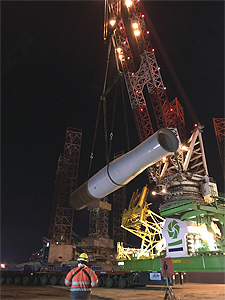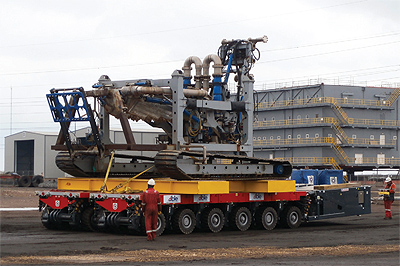ABLE UK: 50 Years of Innovation in Decommissioning and Offshore Wind
Competent decommissioning
ABLE UK’s history dates back to 1966, when its current Executive Chairman, Peter Stephenson, started the business which developed a focus on managing complex demolition processes. In the ensuing years, the company became a market leader in this specialism, but also developed expertise in other sectors, notably oil and gas. “Although we had already achieved some success, the real  impetus in moving forwards in this sector was the acquisition of what is now the Able Seaton Port in 1996,” Neil Etherington – Business Development Director of ABLE UK, begins. “Standing by our commitment to make ongoing investments in the location has enabled us to turn it into a fit for purpose centre for decommissioning, mobile oil rig upgrading, and offshore wind farm installations. I like to think that we have a reputation for putting our money where our mouth is!”
impetus in moving forwards in this sector was the acquisition of what is now the Able Seaton Port in 1996,” Neil Etherington – Business Development Director of ABLE UK, begins. “Standing by our commitment to make ongoing investments in the location has enabled us to turn it into a fit for purpose centre for decommissioning, mobile oil rig upgrading, and offshore wind farm installations. I like to think that we have a reputation for putting our money where our mouth is!”
The Able Seaton Port boasts a perfect location in the centre of the UK, close to the mouth of the River Tees. In the last 20+ years since acquisition, ABLE UK has invested more than £100 million in developing it, and today, it features over 600m of quays, spanning over 51 hectares of land, including the potential to re-establish the ten-hectare dry dock, one of the world’s largest. The facility has been strategically upgraded to suit the requirements chiefly of the oil and gas and offshore wind sectors and ABLE UK’s clients can now make the most of over 9000 square metres of indoor fabrication, warehousing, and storage space available, as well as additional 3000 square metres of welfare and office facilities that can be modified to meet individual clients’ needs.
The largest decommissioning project ABLE UK is currently working on, is the decommissioning of the Shell Brent oil and gas field in the East Shetland Basin of the North Sea, starting with the Delta topside. The undertaking has already seen the deployment of the Pioneering Spirit – the world’s largest vessel – for single lift removal of large offshore facilities, capable of carrying up to 48,000 tonnes and worth £2.5 billion. “In order to accommodate a 24,200-tonne topside, you also need an impressive and reliable quay, too. This is why we designed and constructed a new bespoke quay, Quay 6, which is one of Europe’s heaviest load out quays,” Neil tells us. ABLE UK has contracted to recycle a minimum 97 per cent of the topside material during the Brent oilfield decommissioning project. The processing of the topsides onshore and the recycling of the material has created almost 50 new jobs in the development of the new quay – which ABLE both designed and constructed – and in the recycling/dismantling process.
Developing credentials
Neil is however quick to point out that the continued growth in the decommissioning sector will continue to see a variety of different techniques deployed. “Whilst the large-scale single lift seems to capture the headlines, reverse engineering and small approaches will still play an important role and we are by no means only engaged in the larger single lift projects. The BP North West Hutton project is a good example of ‘conventional’ reverse engineering. The North West Hutton project in question was the largest oil rig recycling project at the time of its implementation between 2008 and 2009. It included the removal of a 20,000-tonne topside and a 10,000-tonne jacket, using a selection of barges, including the Hereema H627 with a load capacity of 52,481 tonnes, which delivered the largest sections of the construction to Able Seaton Port.”
ABLE UK has recently made strides in the wind power sector that have proven fruitful and well-timed. Early in 2018, the Able Seaton Port was contracted to provide the installation base and a  range of associated services for the foundation package of the Hornsea Project One offshore wind farm – a site that will have a total capacity of 1.2 GW of power, thus giving it the capability to serve more than one million homes in the UK. Neil is delighted with the ways that the company is developing its credentials in the sector: “It is a project of a significant scale and importance, as Hornsea will become the world’s largest offshore wind farm when it is completed. We handle all of the onsite logistics and move monopiles weighing almost 1000 tonnes, together with 174 transition pieces of 350 tonnes. The work we are doing is helping us establish a track record, and it is always much easier to win new business when you can show a portfolio of the works you have done in the past. I hope that at some point in the future, we will get the chance to demonstrate our capabilities not just in foundation installation, but also in the installation of the turbines themselves,” he asserts, also mentioning that the wind energy sector is an emerging one, where possibilities are shaping up nicely, especially with the abundance of future projects expected to get underway, such as Hornsea Two and Three, and both Statoil/SSE’s and Innogy’s extensive Dogger Bank projects which, in total have a 4.8GW capacity.
range of associated services for the foundation package of the Hornsea Project One offshore wind farm – a site that will have a total capacity of 1.2 GW of power, thus giving it the capability to serve more than one million homes in the UK. Neil is delighted with the ways that the company is developing its credentials in the sector: “It is a project of a significant scale and importance, as Hornsea will become the world’s largest offshore wind farm when it is completed. We handle all of the onsite logistics and move monopiles weighing almost 1000 tonnes, together with 174 transition pieces of 350 tonnes. The work we are doing is helping us establish a track record, and it is always much easier to win new business when you can show a portfolio of the works you have done in the past. I hope that at some point in the future, we will get the chance to demonstrate our capabilities not just in foundation installation, but also in the installation of the turbines themselves,” he asserts, also mentioning that the wind energy sector is an emerging one, where possibilities are shaping up nicely, especially with the abundance of future projects expected to get underway, such as Hornsea Two and Three, and both Statoil/SSE’s and Innogy’s extensive Dogger Bank projects which, in total have a 4.8GW capacity.
Neil believes that the company’s status, as a privately-owned business, has helped ABLE UK model its strategic vision more easily over the years. “We invest a lot and all of our investments come from our own internal resources, which makes us more flexible and gives us a complete control of our destiny. Being a privately-owned company has allowed us to project our investment programmes against a longer than usual timescale which also helps us to effectively futureproof the business. For example, there is a clear trend of vessels getting bigger and bigger, so we aim to have the facilities that will serve these in the next 15 years, rather than just in the short-term and our £6m capital dredging programme, completed in 2017 and providing -9.5m CD in the entrance channel, is very much a case in point. This ownership structure of our business, and our longer-term strategy provides a distinctive advantage over many conventional PLCs,” he maintains.
The rest of 2018 will see ABLE UK complete the Brent Delta topside with the next two topsides, Bravo and Alpha expected in 2019 and 2020 respectively. He concludes by sharing the business’ long-term vision: “We want to stay ahead, to keep investing and improving, and to reach sufficient capacity to accommodate the potential that is going to occur both in decommissioning and offshore wind farm installation.”
ABLE UK
Services: Demolition, oil and gas rig maintenance, marine decommissioning